Archive for the ‘Botany for Gardeners’ Category
Friday, September 27, 2013
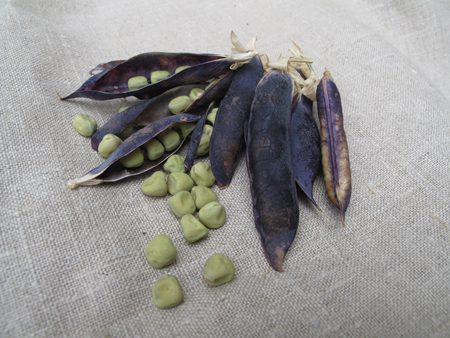
Beautiful Blue Pod Capucijner (Pisum sativum arvense, var. ‘Blue Pod Capucjiner’) seedpods and seeds. All photographs by the author
How many of you gardeners out there take the time to save your garden seed? The allure of planting seeds in the spring is easy to understand, but do you linger over drying seedpods later in the season, waiting to harvest next year’s generation? Seed saving may seem like an onerous counterpart to seed sowing, but the task is endlessly rewarding. It’s not just about securing a free source of new plants for the following year or two; there are other benefits to reap, so to speak. By selecting seed from among the garden’s most healthy specimens you promote added vigor in subsequent generations of plants. You get to witness the often overlooked beauty of a plant engaged in seed production. And, really, is there anything more satisfying than sowing the seed you collected from your own garden? For the seed-saving gardener, it doesn???t get much better than that.
Read more »
Tags: Blue Pod Capucijner, castor bean, corn poppy, Datura, Datura metel, Glaucium flavum, henbane, horned poppy, Mandragora officinarum, mandrake, Ricinus, sea poppy, seed, seedhead, seedpod, seeds, stavesacre
Posted in Botany for Gardeners, Gardening at The Cloisters | Comments (3)
Friday, May 10, 2013

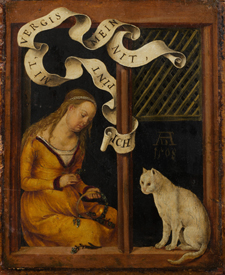
The forget-me-not’s associations with love and remembrance date to the Middle Ages, and were expressed in both the Old French and Middle High German names for this pretty little flower. Left: a pot of forget-me-nots on the parapet in Bonnefont garden. Photograph by Carly Still; Right: a young woman making a chaplet of forget-me-nots on the reverse of a portrait of a young man painted by Han Suess von Kulmbach. The legend on the banderole says “I bind with forget-me-nots.” See Collections for more information about this work of art.
A medieval symbol of love and remembrance that still decorated many a Victorian valentine, the forget-me-not (Myosotis scorpioides) was already known as ne m’oubliez mye in Old French and as vergiz min niht in Middle High German. The etymological and iconographic evidence for the forget-me-not’s medieval significance is ample, but the frequently repeated story of a German knight who tossed the forget-me-nots he had picked for his lady to her as he drowned, imploring her to remember him, is of the “as legend has it” variety. Margaret Freeman, who cites the use of forget-me-not as a token of steadfastness by several fifteenth-century German love poets, speculates that the color blue, associated with fidelity in the Middle Ages, may have contributed to the flower’s meaning.
Read more »
Tags: borage, Dioscorides, forget-me-not, Henry IV, Hildegard of Bingen, Myosotis scorpioides, scorpion, Scorpiurus sulcatus
Posted in Botany for Gardeners, Gardening at The Cloisters, Plants in Medieval Art | Comments (0)
Friday, February 8, 2013
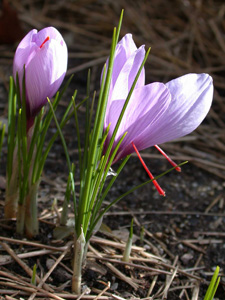
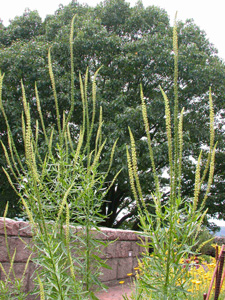
Incomparably the most important yellow in medieval painting is the metal gold. Yellow pigments, however, played a significant part in the pageant of medieval technique. One of the most important services required of them was to imitate the appearance of gold. Another of their chief functions was to modify the qualities of greens, and to a less extent, of reds. Of all their uses, perhaps the least important was to represent yellow things.
???Daniel Thompson, The Materials and Techniques of Medieval Painting
The vegetable yellows used in medieval illumination were more readily prepared and much safer to use than mineral yellows like realgar or orpiment. Above, left: The brilliant red-orange stigmas of the autumn-blooming saffron crocus, used by medieval cooks as a colorant and a seasoning, were also exploited by illuminators. Right: Flower spikes of weld, the most ancient yellow dyestuff known. When processed as a pigment, this weedy biennial provided manuscript painters with a bright vegetable yellow.
A number of plants were exploited for coloring matter in the Middle Ages, whether to tint foodstuffs or to furnish dyes and pigments. By no means all, or even many, artist’s pigments were of vegetable origin; mineral colors were used for wall painting, where the more delicate and fugitive nature of vegetable colors was inappropriate. In book painting, a combination of vegetable and mineral colors was employed. The same plant that yielded a dye for textiles could be prepared as a pigment and used by illuminators. Several species produced a viable yellow, including weld, saffron, and celandine; as Daniel Thompson observes, these vegetable yellows served both to imitate the appearance of gold, and to modify greens and reds.
Read more »
Tags: acacia, celandine, Chelidonium majus, Crocus sativus, greater celandine, gum arabic, illumination, manuscript, Reseda luteola, saffron, weld
Posted in Botany for Gardeners, Plants in Medieval Art | Comments (1)
Thursday, October 4, 2012
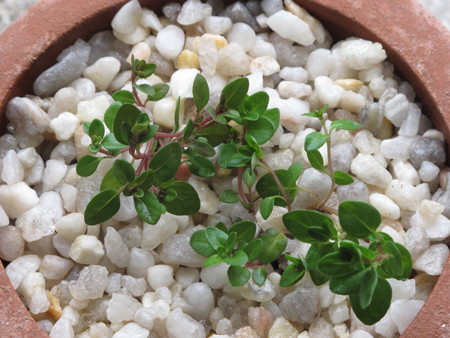
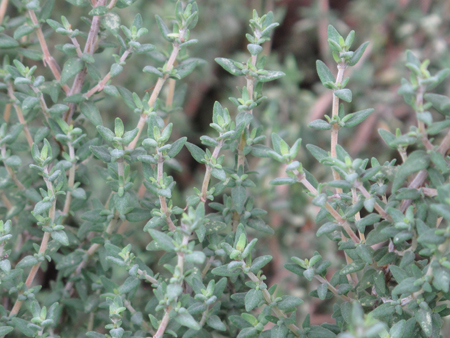
From right to left: A small start of wild or creeping thyme, a native of Northern Europe, in a terra rossa pot; detail of a planting of common or garden thyme, indigenous to the Western Mediterranean, growing in a sunny bed under the parapet wall in Bonnefont cloister. Although these two plants are easily distinguished in the garden, it can be difficult to know which of several species of thyme is under discussion in ancient and medieval sources.
There are hundreds of?? species in the genus Thymus, and a large and confusing array of hybrids and cultivated forms.??Ancient and medieval sources agree on the heating and drying properties of thyme, which is still greatly valued for its antibacterial and antifungal properties, but the species known in the European Middle Ages were not those of the ancients. The attempt to equate the plants discussed by Dioscorides in the De Materia Medica with more familiar species would occupy botanists well into the Renaissance.
Read more »
Tags: Dioscorides, Hildegard of Bingen, Pliny, thyme
Posted in Botany for Gardeners, Food and Beverage Plants, Fragrant Plants, Gardening at The Cloisters, Medicinal Plants | Comments (1)
Wednesday, August 15, 2012
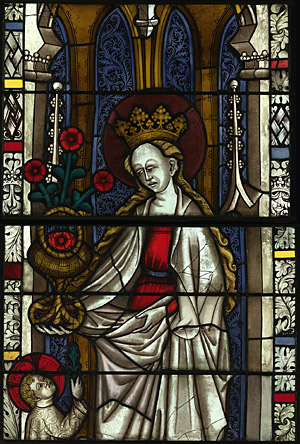
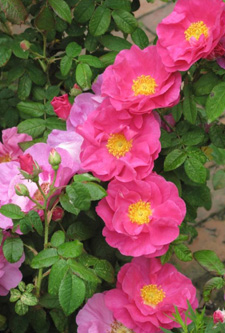
Left:?? Roses are one of the special attributes of Saint Dorothea, as shown in the detail of this stained-glass panel; Right: Rosa gallica officinalis blooming in Bonnefont garden. Remarkably, the rose has retained its ancient name in dozens of modern languages.
The rose has been known by the same name throughout Europe since antiquity. It began as vrda in ancient Persia (related to the modern Arabic warda) and became known as rhodon to the nearby ancient Greeks. (Oddly, the modern Greek for rose is triantafillo, meaning “thirty leaves,” while rhodon remains in our “rhododendron,” meaning “rose tree”). By the time of the Roman Empire the name had become rosa, immediately recognizable in most modern European languages???rosa (Italian and Spanish), roos (Dutch), ros (Swedish), rosier (French)???and many others, including the Japanese rozu.
Read more »
Tags: carline thistle, Dioscorides, etymology, herb robert, Hildegard of Bingen, Linnaeus, Physica, rose, Theophrastus
Posted in Botany for Gardeners | Comments (2)
Monday, July 16, 2012


The courtyard, as seen from the portcullis gate entrance in 1938, at left, and in 2012, at right. Photograph on right by Andrew Winslow
Visitors to The Cloisters may have spied the top of a large oak tree just above the wall at the postern gate entrance. This white oak grows in a courtyard enclosed by the ramparts, which also include maintenance passages, storage, an education workshop area, and garden workspaces.
Read more »
Tags: acorn, oak, Quercus, tree
Posted in Botany for Gardeners, Gardening at The Cloisters, Useful Plants | Comments (3)
Friday, February 24, 2012

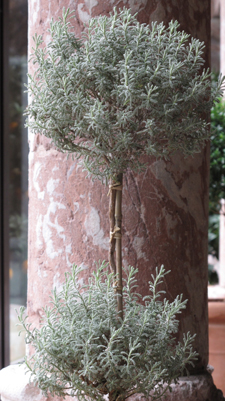
The ‘evergray’ santolina is cold hardy in our climate, but dislikes our wet winters. We prefer to grow this aromatic herb in pots and bring it indoors in autumn. Above, left: Santolina is also known as cotton lavender, because of its dense, whitish-gray foliage and strong fragrance; Right: A santolina topiary made from a dwarf form of the species.
A compact, woody plant of dry ground and stony banks, the Mediterranean santolina (Santolina chamaecyparissus) is cold hardy in our USDA Zone 7 gardens, but dislikes wintering over in wet soil; we prefer to grow it in pots and bring it indoors in autumn. Santolina’s slender stems are densely covered with short, thick, cottony leaves. This low-growing evergray species lends itself to shaping and shearing, and was widely used as an ornamental edging plant in Renaissance knot gardens. It’s also an excellent subject for topiary work, especially the dwarf form of the species, S. chamaecyparissus ‘Nana.’
Read more »
Tags: Andres de Laguna, artemisia, cherry, cornelian, Cornus europaea, cornus mas, De Materia Medica, Dioscorides, evergray, santolina, Santolina chamaecyparissus, southernwood, topiary, wormwood
Posted in Botany for Gardeners, Gardening at The Cloisters | Comments (2)
Friday, November 18, 2011
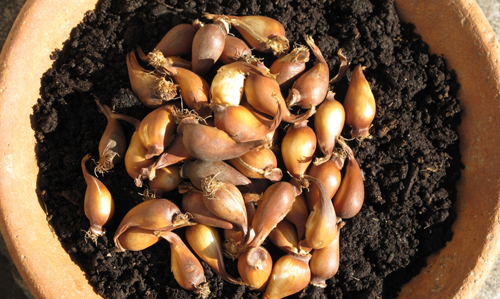
These small bulbs of Tulipa biflora, a species native to the Southern Balkans and Southeastern Russia, are to be planted today in Cuxa garden, the only one of our three gardens in which ??post-medieval plants are grown. The tulip did not reach Europe until the sixteenth century.?? Photograph by D. Larkin
Tulips, spring-blooming crocuses, winter aconites, fritillarias, and other bulbous plants native to Asia came too late to Europe to find a home in the medieval plant collections in Bonnefont and Trie gardens, but they do have an honored place in Cuxa cloister garden. Cuxa has been the main ornamental garden for the Museum since 1938, and has always included both modern and medieval plants in order to provide a continuous display from early spring until late fall. Read more »
Tags: Bulbs, Fritillaria, Holland, Linnaeus, tulip, Tulipa biflora, Tulipa humilis, Tulipa saxatilis, Tulipa turkestanica, winter aconite
Posted in Botany for Gardeners, Gardening at The Cloisters | Comments (0)
Thursday, July 21, 2011
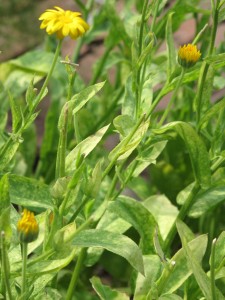
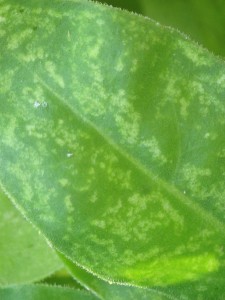
Left: A severe infestation of two-spotted mites on a calendula growing in Bonnefont garden. Right: A detail of the damage done by this common hot-weather garden pest, which sucks the chlorophyll from the leaves of the host plant. Photographs by Corey Eilhardt
The hot, dry weather that has us struggling to keep the gardens watered is all too welcome to the two-spotted mite, Tetranychus urticae, a worldwide pest of crop plants, ornamentals, and houseplants that is as much at home in greenhouses and apartments as it is outdoors. Two-spotted mites, along with other members of the Tetranychus family, are commonly known as spider mites. They are arachnids but are more closely related to ticks than to spiders.
Read more »
Tags: Bonnefont Garden, Calendula officinalis, catmint, hops, humulus lupulus, lady???s mantle, Levisticum officinale, lovage, meadow rue, Nepeta x faassenii, pest, Phytoseiulus persimilis, pot marigold, spider mites, Tetranychus urticae, Thalictrum aquilegifolium, two-spotted mite
Posted in Botany for Gardeners, Gardening at The Cloisters | Comments (2)
Friday, July 8, 2011

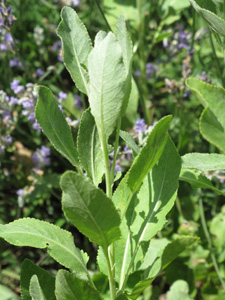
Hops (Humulus lupulus), considered today to be crucial to beer brewing, were not commonly used until the fifteenth century. Before that time, brewers added different herbs, such as??alecost??(Tanacetum balsamita), to their beer to improve its flavor. Several of these medieval brewing herbs can be found in Bonnefont garden.
Ale is made of malte and water; and they the which do put any other thynge to ale then is rehersed, except yest, barme, or godesgood, doth sofystical theyr ale.
???Andrew Borde, The fyrst boke of the introduction of knowledge, 1452
Beer was a staple drink for medieval Europeans, as it provided much-needed calories to the often undernourished population and was cleaner and safer to drink than water. Then, as now,??beer was made by brewing malted barley in boiling water to make sugars more available for yeasts to consume (see an image of Jorg Prewmaister tending his brew in a page from a fifteenth-century German manuscript, Amb. 317.2). This sugary, malty potion, known as “wort,” eventually becomes beer after the yeasts eat the sugars, releasing carbon dioxide and alcohol as byproducts of fermentation. On its own, wort is fairly flat in flavor, so brewers add additional ingredients, such as hops and spices, to enliven a beer’s taste.
Read more »
Tags: Achillea millefolium, Add new tag, ale, alecost, barley, beer, brew, bryan_stevenson, costmary, Glechoma hederacea, ground ivy, gruit, hops, humulus lupulus, Ledum palustre, malt, Myrica gale, Reinheitsgebot, stinging nettle, sweet gale, Tanacetum balsamita, Urtica dioica, wild rosemary, wort, yarrow
Posted in Botany for Gardeners, Food and Beverage Plants, Fragrant Plants, Medicinal Plants | Comments (3)


















